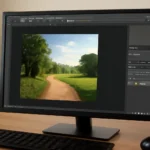Are you looking to master the art of creating a Photoshop mosaic? In this guide, we’ll cover how to make, erase, and customize mosaic effects in Photoshop, exploring the best tools and techniques for achieving stunning visual results. Ready to learn all about it?
Making a Photoshop Mosaic
Photoshop offers various ways to create a mosaic effect, which can transform any image into a captivating artwork. Whether you’re aiming for a pixelated look or trying to enhance the visual texture of an image, understanding the core process is essential.
1. Using the Mosaic Filter
The simplest way to create a mosaic in Photoshop is by using the built-in mosaic filter. This filter pixelates the image, creating the blocky, grid-like effect typically seen in mosaics. To do this:
-
Open your image in Photoshop.
-
Go to
Filter>Pixelate>Mosaic. -
A dialog box will pop up where you can adjust the cell size, which determines how large or small the blocks of the mosaic will be.
This is perfect for giving your image an abstract, pixelated appearance while retaining some of the original colors and shapes.
2. Applying a Photoshop Mosaic Brush
Another way to create a mosaic effect is through the use of brushes. Photoshop’s brush tools allow you to manually create tile-like patterns that mimic the look of a mosaic. Here’s how:
-
Select the Brush Tool (
B). -
Choose a mosaic-like brush from the Brush panel, or create a custom one.
-
Paint over your image where you want the mosaic effect, adjusting the brush settings (size, flow, opacity) as needed.
This technique gives you more control over where and how the mosaic is applied, making it a great choice for artistic designs.
3. Using a Photoshop Mosaic Pattern
If you want to create a more intricate mosaic, you can use Photoshop’s pattern tools to apply a specific mosaic tile pattern. You can either use existing patterns or create your own.
-
Open the pattern options in the Fill dialog box or Pattern Stamp tool.
-
Choose a square or geometric pattern that mimics tiles.
-
Apply the pattern across your image, adjusting the scale for the desired look.
This method is useful for achieving a more detailed and organized mosaic effect, often used in design projects or complex photo manipulations.
👉 Learn more about Photoshop Mosaic Filters 👈
Erasing a Photoshop Mosaic
Sometimes, you may want to remove or erase the mosaic effect you’ve applied, especially if it was overdone or didn’t achieve the desired results. Photoshop provides several ways to undo or soften the effect without losing the entire image.
1. Using the History Brush Tool
One method to erase the mosaic effect is by using the History Brush Tool. This tool allows you to paint back areas of your image to a previous state before the mosaic effect was applied.
-
Open your image in Photoshop.
-
Go to the History panel and select the state before applying the mosaic.
-
Select the History Brush Tool (
Y), and carefully paint over the areas where you want to remove the mosaic effect.
This approach is ideal for selectively erasing the mosaic, especially when it’s only applied to specific parts of the image.
2. Masking the Mosaic Effect
Another non-destructive method is using a mask to hide the mosaic effect. This method works by adding a layer mask and painting over the areas where you want to soften or erase the mosaic.
-
Select the layer with the mosaic effect.
-
Add a mask by clicking the “Add Layer Mask” icon at the bottom of the Layers panel.
-
Use a soft brush and paint with black on the mask to hide the mosaic, or white to bring it back.
This technique offers flexibility, as you can easily adjust the mask and reapply the mosaic effect if needed.
3. Reducing Mosaic Intensity
If the mosaic effect is too intense, you can reduce its strength by lowering the opacity of the layer or by using the “Gaussian Blur” filter to soften the blocks.
-
Select the mosaic layer.
-
Go to
Filter>Blur>Gaussian Blur. -
Adjust the radius to soften the pixelation.
This method is effective if you want to keep the mosaic effect but make it less harsh or less distracting.
👉 Learn more about removing Photoshop mosaic effects 👈
Photoshop Mosaic: Exploring Apps and Filters
While Photoshop is the go-to tool for professionals, there are several apps and filters designed to make mosaic creation even easier and more accessible for beginners or for those looking for quicker solutions.
1. Photoshop Mosaic App
For users on the go, there are mobile apps that offer easy-to-use mosaic effects. These apps often include templates and preset styles, allowing users to turn their photos into mosaics with just a few taps.
Apps like Pixlr and Mosaic Art Lab can quickly transform images into a mosaic, often with a variety of customizable options to fit your needs.
These apps usually offer both automatic filters and manual editing features, giving you flexibility in how the mosaic effect is applied.
2. Photoshop Mosaic Filter
The Photoshop Mosaic Filter is a classic feature that continues to be used for creating pixelated effects. You can tweak the size of the blocks to get a finer or coarser look. This filter is typically used for abstract artwork or to create a stylized version of a photo.
For a more artistic touch, the Mosaic Tiles filter can create an even more structured and cohesive pattern, ideal for designers working on print materials or web graphics.
3. Custom Brushes for Mosaics
Creating custom brushes for mosaics can also help you add unique texture to your images. By designing brushes with various shapes (like square tiles or even irregular shapes), you can control the mosaic pattern and experiment with the results. This is perfect for artists and graphic designers looking to create one-of-a-kind effects.
👉 Discover Photoshop Mosaic Apps and Filters 👈
Conclusion
Creating and modifying a Photoshop mosaic can transform ordinary images into extraordinary works of art. Whether you’re applying a basic pixelated filter, using mosaic brushes, or experimenting with apps, the possibilities are endless. Mastering these techniques allows you to enhance photos, create abstract designs, or even add a creative touch to your projects.
With these tips, you’ll be able to apply and remove mosaic effects with ease, ensuring you get the perfect outcome every time. Let your creativity run wild with Photoshop’s mosaic tools, and explore new ways to bring your vision to life!






